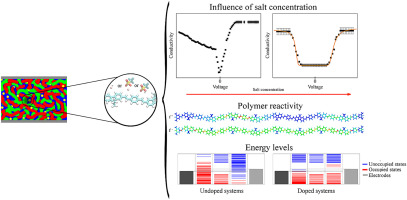Organic Electronics ( IF 2.7 ) Pub Date : 2020-01-13 , DOI: 10.1016/j.orgel.2020.105629 Levy A. Galindo , Giovani Gozzi , Lucas Fugikawa-Santos , Roberto M. Faria , Francisco C. Lavarda , Augusto Batagin-Neto

|
Polymer light-emitting electrochemical cells (PLECs) are organic electronic devices which operating mechanism depends on the injection and transport of electronic charge carrier and the electrochemical doping of the organic semiconductor. The details of the interactions between the salt (or its ions) and the semiconducting polymer composing the device active layer provide important information about the electronic processes associated to the device operation in steady-state. In this context, the present paper proposes a study where theoretical results from Density Functional Theory (DFT) were obtained for three different steady-state operational regimes: i) without external voltage, in which the undissociated salt molecules interact with uncharged semiconducting polymer; ii) for applied voltages lower than the device turn-on (), in which dissociated ions interact with uncharged semiconducting polymer; iii) for applied voltages higher than the turn-on (), in which the dissociated ions interact with charged semiconducting polymer. In addition, the theoretical results have been confronted with experimental results of PLECs fabricated using different salt concentrations. For both theoretical and experimental approaches, we considered lithium triflate as the salt compound and poly[(9,9-dioctylfluorenyl-2,7-diyl)-co-(1,4-vinylenephenylene)] (F8PV) as the semiconducting polymer. We observed substantial changes in the electronic structure of the systems at the different operating regimes, which were interpreted in terms of the electronic charge injection from the electrodes and the electrochemical doping of the semiconducting polymer.
中文翻译:

聚合物发光电化学电池中聚合物-盐相互作用的研究:电子结构计算和实验研究
聚合物发光电化学电池(PLEC)是有机电子设备,其运行机理取决于电荷载体的注入和传输以及有机半导体的电化学掺杂。盐(或其离子)与构成器件活性层的半导体聚合物之间的相互作用的详细信息提供了与稳态下与器件操作相关的电子过程的重要信息。在这种情况下,本文提出了一项研究,其中从密度泛函理论(DFT)获得了三种不同的稳态操作方式的理论结果:i)没有外部电压,其中未离解的盐分子与不带电荷的半导体聚合物相互作用;ii) 适用于低于设备开启电压(),其中离解的离子与不带电的半导体聚合物相互作用;iii)对于高于接通电压的施加电压(),其中离解的离子与带电的半导体聚合物相互作用。另外,理论结果与使用不同盐浓度制备的PLEC的实验结果相面对。对于理论方法和实验方法,我们都将三氟甲磺酸锂视为盐化合物,并将聚[(9,9-二辛基芴基-2,7-二基)-共-(1,4-亚乙烯基亚苯基)](F8PV)作为半导体聚合物。我们观察到在不同的操作方式下,系统的电子结构发生了实质性变化,这可以通过电极的电荷注入和半导体聚合物的电化学掺杂来解释。











































 京公网安备 11010802027423号
京公网安备 11010802027423号